Nissan Bluebird (1986 – 1990) Review
Nissan Bluebird (1986 – 1990) At A Glance



The Nissan Bluebird has a complex genaeology behind it - and is also a hugely important car in manufacturing industry terms. Shame, then, that the car itself is really rather dull. First thing to remember is that when the '86 Bluebird was launched, it was replacing a car with the same name that had only been on sale in the UK for a couple of years. And that's because the Bluebird T12/T72 was actually the second-generation T11-generation Stanza (as we knew it) or Auster. Viewed in that way, the evolution of the first UK-built Nissan becomes a whole lot simpler.
It was also the first car that Nissan built at its greenfield factory in Washington in the North East. Being a UK-built product, the Bluebird range was devised very much with fleet car managers in mind. So it was possible to buy in a wide variety of trim levels and 1.6- and 2.0-litre petrol form and with the minicabber’s favourite 2.0-litre diesel. All were capable and competitive in the power and economy stakes, as was the 1.8-litre turbo that found its way into the ZX and Executive variations. Dynamic and ergonomic masterpieces they weren’t though – and when pitched against the class-leading Montego and Peugeot 405, the Bluebird was found wanting by the contemporary road testers. But, boy, was it well-made and reliable - and consequently, it's not that unusual to see 25 year old examples still being used on a daily basis.
Model History
- February 1984: Nissan agrees to set-up UK assembly plant in the UK
- March 1984: A greenfield site located in Washington is chosen for the new factory
- November 1984: Work begins on the new site
- April 1985: The site is set-up as a 'single-union' factory
- December 1985: Factory building completed
- March 1986: Nissan Bluebird T12 introduced in the UK
- September 1986: The completed plant is opened
- February 1987: All UK Bluebirds now built in the UK
- January 1988: Bluebird mildly facelifted
- January 1989: 1.6 Premium and Executive models added to the range
- September 1990: Bluebird ceased production in the UK
February 1984
Nissan agrees to set-up UK assembly plant in the UK
Under the leadership of Nissan's president, Takashi Ishihara, the Japanese car manufacturer and the British government signed an agreement to build a car plant in the UK. The idea had first been mooted by the UK government way back in February 1980.
March 1984
A greenfield site located in Washington is chosen for the new factory
A 799-acre greenfield site near Sunderland, Tyne and Wear, was chosen for the new facrtoy. The North East region had been enduring a sustained period of industrial decline, with the closure of most of the shipyards on the Wear and Tyne, and the closure of many coal mines on the once prosperous Durham coalfield.
The high unemployment rate in the area meant Nissan had a large, eager, manufacturing-skilled workforce to draw upon. The site, once the Sunderland Airfield (formerly RAF Usworth), was close to ports on the Wear and Tyne, within easy driving distance of the international Newcastle Airport, and close to major trunk roads such as the A1 and A19. The established company became known as Nissan Motor Manufacturing (UK) Ltd, or NMUK.
November 1984
Work begins on the new site
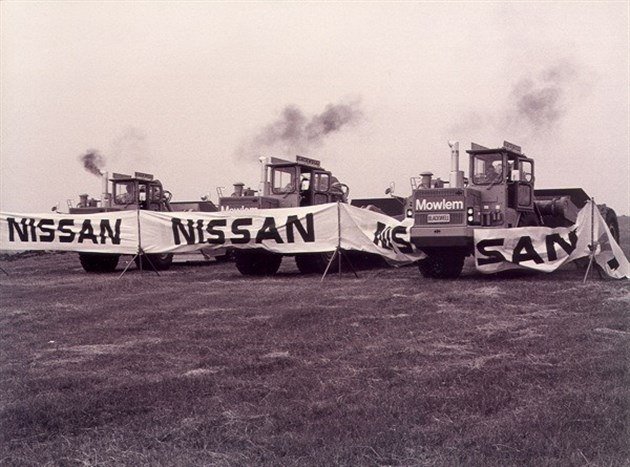
A ground breaking ceremony had taken place in July, and work began on the site in November 1984, by building contractors Sir Robert McAlpine (above).
April 1985
The site is set-up as a 'single-union' factory
An agreement was reached with the Amalgamated Engineering Union (AEU) allowing the plant to become a single-union site. Nissan stated that as a result of the single-union agreement, its workforce was - and is - much more flexible than at other plants, and the fact that there have been no strikes or associated industrial action in the factory since it opened.
December 1985
Factory building completed
In December 1985, McAlpine handed over the completed factory building to Nissan for the installation of machinery and factory components, ahead of schedule.
March 1986
Nissan Bluebird T12 introduced in the UK
New T12 model introduced in the UK. Like the previous U11 model, which had only been on sale for around 18 months, it was a conventionally engineered front-wheel drive saloon, offered in four-door saloon and five-door hatchback forms, and 1.6- and 2.0-litre forms. Much was made by Nissan that these cars had been tuned specifically for UK market tastes, although like the older Bluebird (and the Stanza it directly replaced globally), the Bluebird's styling didn't reflect a Western-looking company's ambitions.
Original range consisted of 1.6L, and LX, 1.8LX and SLX, Turbo ZX, 2.0SLX ans SGX, and the 2.0DX. Although this was a much wider and more fleet-friendly model line-up than previus models, it was still less generous than Ford and Vauxhall's line-ups.
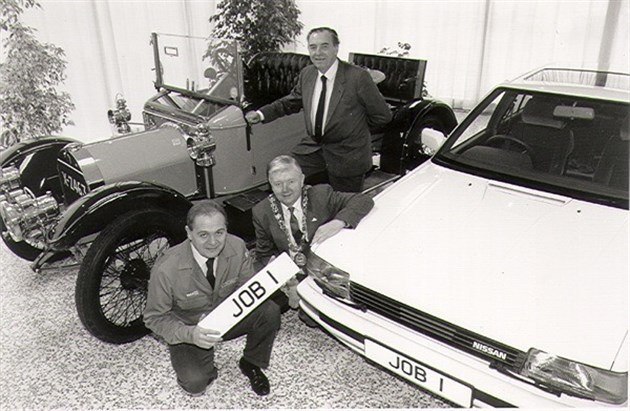
September 1986
The completed plant is opened
 The first Bluebird was produced shortly in August 1986 (above), and the official opening took place the following month - Prime Minister Margaret Thatcher and Nissan President Yutaka Kume (right) attended the site opening. Margaret Thatcher also painted the second eye on a traditional Japanese ‘daruma’ doll to confirm the successful opening of the plant. This followed the painting of the first eye by Prince Charles and Princess Diana during a visit to Nissan’s Zama Plant in Japan.
The first Bluebird was produced shortly in August 1986 (above), and the official opening took place the following month - Prime Minister Margaret Thatcher and Nissan President Yutaka Kume (right) attended the site opening. Margaret Thatcher also painted the second eye on a traditional Japanese ‘daruma’ doll to confirm the successful opening of the plant. This followed the painting of the first eye by Prince Charles and Princess Diana during a visit to Nissan’s Zama Plant in Japan.
Bluebird production was still building at this point, and it initially supplemented UK assembled models with ones imported in from Japan. In the first year of production, 5139 Bluebirds roll off the line, and 430 people are employed there.
February 1987
All UK Bluebirds now built in the UK
By February 1987, NMUK had become the sole supplier of the Bluebird model to the UK market, but with the majority of components imported from Japan. But with the beginning of Phase 2 of the operation, where a new plastics moulding and engine assembly facility being instigated, the Bluebird would end up containing far more 'local' content. Initially four-door Bluebirds were assembled in the UK, but at this point in time, the five-door started production in Washington, too.
January 1988
Bluebird mildly facelifted
The Bluebird received a new raditor grille and bumpers as well as a model re-shuffle for its first facelift. The new model, now known as the T72, saw the 1.6L replaced by the 1.6LS, the 1.8LX replaced by the 1.8GS, and the 1.8SLX dropped from the range. The 2.0SLX and SGX were also dropped, to be replaced by a new 2.0GSX version, which after six months, was fuel injected to become the 2.0iGSX. All models looked more contemporary thanks to colour-coded bumpers, and received additional equipment - but still failed to make significant inroads into the fleet market, despite Nissan make great play of the car's UK status.
January 1989
1.6 Premium and Executive models added to the range
September 1990
Bluebird ceased production in the UK
The Bluebird is replaced by the Primera after a production run of 187,178 in the UK.
Driving Nissan Bluebird (1986 – 1990)
The Nissan Bluebird's main claim to fame in automotive history is that it was the company's first UK-assembled car at its greenfield site in the North East of England.
The car itself hardly blazed a trail during the greed-is-good 1980s, setting out its stall as a roomy, tough, and reliable family car that would always get you to where you needed to go in one piece. So, worthy but dull? Yes and no - in some ways, it's a bit of a surprise...
Classic road test: Nissan Bluebird 1.6LX
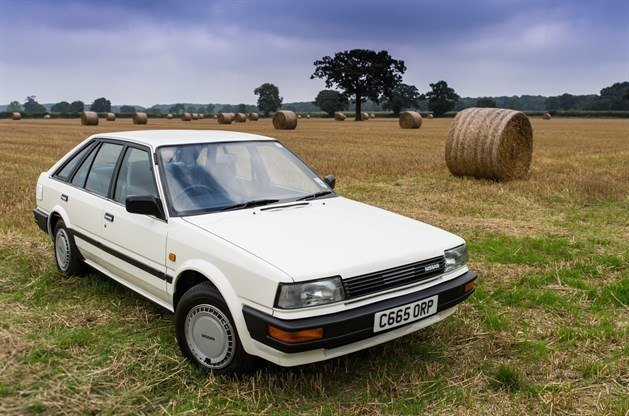
The Nissan Bluebird really was a case of '...from little acorns'. When one considers just how much of a manufacturing collossus Nissan Motor Manufacturing UK now is, with around half a million cars a year churning out of Washington, it's sometimes easy to forget that the company's first British made car, the Bluebird T12, was actually a bit of a pot-boiler in the sales charts.
But when the Bluebird was launched in 1986, we were still three or four years away from the Japanese revolution, which ended up delivering cutting-edge cars such as the Mazda MX-5, Honda NSX, Lexus LS400, and Nissan's own, and quite brilliant Primera. So, aside from a few honourable exceptions, buyers still had very fixed ideas about Japanese cars, and what they could expect from them. On the whole, the media did its best to maintain the status quo, singing the praises of all Japanese cars' reliability and build quality, while slating them for their sub-standard dynamics.
And the Bluebird was no exception to this rule, despite Nissan claiming quite vocally that its new British-assembled mid-liner had been tuned dynamically for European tastes. The Bluebird T12 was starting from quite a low base. The model line was a long-standing stalwart of the UK middle-market, and throughout the 1970s had sold reasonably well on the strength of its reliability, high equipment levels, availability (getting hold of a Cortina or Marina during the strike-torn '70s sometimes involved joining a waiting list that ran into years), and extremely good value.
A good example of this was the 910-series, introduced in 1980. Visually, it was a very effective clone of the Ford Cortina MkIV, and it was also astonishing value. For the price of an entry-level Cortina 1.3L, you could buy a fully-loaded Bluebird 1.8GL that could literally run rings around its British rival. It had oodles of showroom appeal, and looked good on paper, but it ended up mainly selling to private buyers. The more discerning fleet market demanded lots of dealers, low running costs, and motorway friendly dynamics for hard-pushed reps - and the Bluebird was found wanting.
That was replaced by the front-wheel drive U11-series Bluebird in 1984 - a car that looked little different from its predecessor, and was all-new under the skin. It proved to be a disappointment. The U11 lasted a mere two years on the UK price lists before it was replaced by the all-new T12 - and if that seems like an unusually short lifespan, that's because the 1986 Bluebird was actually a direct replacement for the 1981 Datsun Stanza. Confused? Don't be.
About the Nissan Bluebird
As a replacement for the Stanza, it's no surprise to learn that the Bluebird T12 is very similar under the skin. So it has the same transverse engine, end-on gearbox, front-wheel drive layout. All petrol Bluebirds are powered by eight-valve versions of its then-new CA-series engine, with power outputs starting at 82bhp. Front suspension is by MacPerson struts, with anti-roll bar, and at at the rear, it retains the independent semi-trailing arm of its predecessor, too. So, it was mechanically predictable, and also very much on the pace with the opposition under the skin.
Styling-wise, it embraced the origami school of design, very much relying on straight lines and angles to define its character. In the post-Audi 100 and Ford Sierra world, this made it seem curiously old-fashioned, even at launch, although it was far from alone in enjoying dated looks - the Vauxhall Cavalier Mk2, Citroen BX and Austin Montego were all very much in the same boat.
The main differerance from all that came before was that the Bluebird was set-up for serious UK sales volume like no Nissan before it. The company set-up a new fleet sales department, and began aggressively chasing company car managers, and user-choosers. The Bluebird had a good reptutation for reliability and value at the time, and Nissan worked hard to capitalise on this, while playing up the Made in Britain aspect of the car.
On the road
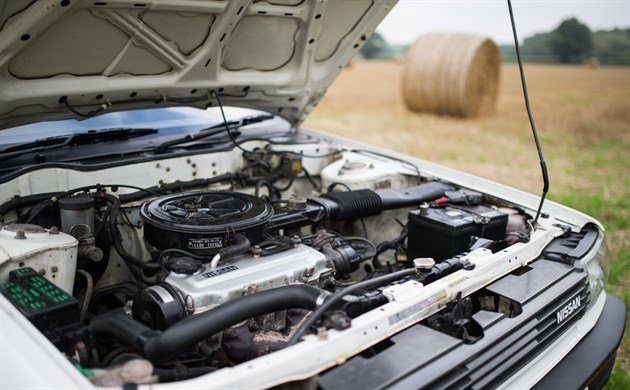
First thing's first - although Nissan UK's Bluebird looks box-fresh and minty, it's no museum piece, and is representative of many of the examples left plying our roads. It has 69,000 miles on the clock, and has seen a little action from the spray gun. But it's original, and looks like it's never been afflicted by even a trace of corrosion. And interestingly, it did attract favourable comments from passers-by whenever it was parked-up.
Inside, it's a rhapsody in blue, with plenty of angular plastic mouldings dotted around the cabin, and matching tweed for the seats. It's all very hard-wearing, but far from stylish. The instuments look stuck in an '80s timewarp, thanks to yellow striping, but they're big and easily-read. The twin-trip meters are a treat, too.
Column stalks operate with reverse logic to those used to modern cars, so the indicators are on the (ergonomically-correct) right hand side, with the wipers on the left. There are some big switches (for hazards, heated rear window) surrounding the instrument pod, but then you also contend with hidden minor controls, such as the rear wash wipe and electric mirrors, which are hidden down by your right knee. It's a low-spec 1.6LX, so there are no electric windows or central locking - but you do get power steering and a radio cassette player.
The cabin itself is airy and blessed with great visibility thanks to slim pillars and a generous glass area. But being slightly smaller than the then class-norm means that in order to give the car acceptable rear legroom, there's not enough rearward travel of the front seats, leaving taller drivers more cramped than they would be in a Cavalier or Montego.
Start-up is typical for automatic-choke set-ups of this era, so you stab the throttle once, turn the key, and it fires instantly, with a smooth tickover. Pulling away, it's immediately obvious that in order to get the best from the Bluebird, you need to give it lots of revs and bet unafraid to use wide throttle openings. Waft it along and change up early as you might a 2.0, and you'll find yourself not moving very quickly at all. But in truth, once you're acclimatised to that, and the fact that the engine - although quiet - is coarse over 4000rpm, and you'll quite happily flow along at 21st century motorway speeds, and that's more than acceptable for a 1.6-litre full-sized saloon of this era.
As for handling and ride, it's there or thereabouts, and far from the tragedy that some journalists of the time declared. On motorways and smooth roads, relatively soft springing result in a surprisingly compliant ride. Potholes and sharp expansion joints rarely crash into the cabin, leaving an overall impression of good ride comfort. The damping is also excellent - but what the Bluebird does suffer from is short suspension travel, which means on lumpy B-roads, it joggles for more than is desirable. Cornering is reasonable, with more poise than you'd expect, and steering feel is also good (a genuine surprise) - but get too playful, and the tyres do start to squeal, 1970s Detroit-style.
The HJClassics Verdict
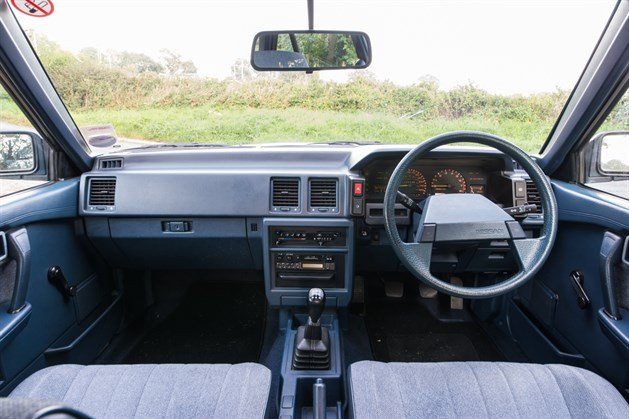
As already stated in the introduction, the Nissan Bluebird's place in history is far more interesting than the car itself - a fact that even its most ardent supporters would have no trouble agreeing with. Its solidity, and ability to rack up huge mileages in one piece without breakdowns or rust are legendary. And yes, that's why so many ended up being private-hire taxis. And as it was made in England, it proved that us Brits can build cars as well as anyone else in the world - refreshing news after generations of being told otherwise.
It's certainly not a bad all-rounder at all - pretty good in fact. But in no way will you be inspired by the Bluebird, or feel the need to get up early just to take it the long way into the office. You'll never love it. The word 'adequate' sums up the Bluebird perfectly - you'll come away from driving one pleasantly surprised (as undoubtedly you'll have entered the experience with low expectations), but hardly uplifted by the experience.
But despite its sheer inability to stir the soul, we couldn't help but like the Bluebird, and respect what the company achieved with it. As white goods go, it's very, very capable - and is very, very easy to live with. But the Bluebird is brilliant in one very important respect: reliabilty. If you want an '80s car that won't let you down, and will always start in the morning, nothing comes close to touching it, especially at today's prices.
And for some, that's all they need from their car.
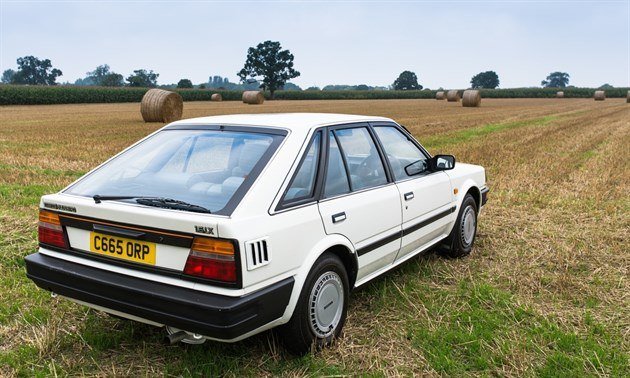
Photography: Richard Kilpatrick
Nissan Bluebird (1986 – 1990) Buying Guide
Good
- Model designated T12 and T72 (pre- and post-facelift).
- This was the second front wheel drive Bluebird, later examples of which were UK built at Sunderland.
- Available as a four-door saloon, a five-door hatchback or a five-door estate car (imported from Japan, and based on the U11-generation Bluebird).
- Introduced with 90bhp overhead cam 1809cc engines, the same block but turbocharged to 135bhp, or a 105bhp 1973cc ohc unit. three-speed auto optional on 1.8; four-speed auto optional on turbo and 2.0.
- Facelift and 82bhp 1.6-litre introduced in March 1986, plus new 1796cc engine with 88bhp. 1.8-litre turbo and 2.0 continued as before.
- 2.0 'Executive' introduced in October 1989 with 115bhp, and ran to the end in September 1990 when the range was replaced by the Primera.
- Always solid and reliable.
- Name used on later Sunnys in Asian markets.
- There is still a 460 strong 'Bluebird' taxi fleet on Bali.
Bad
- Old cars now. Some would say 'stolid' and reliable.
- Banger territory, but previously a great favourite among mini-cabbers, though almost all Bluebirds this happened to will have died.
- Poor parking brakes.
Watch
- Check brakes and suspension carefully.
- Look for signs it's been a family car rather than a mini cab.
- If you're looking at a turbo, it's getting a bit old for a performance car, so check turbo oil seals by getting someone to follow behind on your test drive looking for puffs of black smoke.
- Also check the discs themselves and adjust what you pay if they are lipped or scored.
- (But, of course, you're not going to be paying much anyway.)

.jpg?width=640&height=426&rmode=crop)
.jpg?width=640&height=426&rmode=crop)
.jpg?width=640&height=426&rmode=crop)
.jpg?width=640&height=426&rmode=crop)
.jpg?width=640&height=426&rmode=crop)
.jpg?width=640&height=426&rmode=crop)
.jpg?width=640&height=426&rmode=crop)
.jpg?width=640&height=426&rmode=crop)
.jpg?width=640&height=426&rmode=crop)
.jpg?width=640&height=426&rmode=crop)
.jpg?width=640&height=426&rmode=crop)
.jpg?width=640&height=426&rmode=crop)
.jpg?width=640&height=426&rmode=crop)
.jpg?width=640&height=426&rmode=crop)
.jpg?width=640&height=426&rmode=crop)
.jpg?width=640&height=426&rmode=crop)
.jpg?width=640&height=426&rmode=crop)
.jpg?width=640&height=426&rmode=crop)
.jpg?width=640&height=426&rmode=crop)
.jpg?width=640&height=426&rmode=crop)
.jpg?width=640&height=426&rmode=crop)
.jpg?width=640&height=426&rmode=crop)